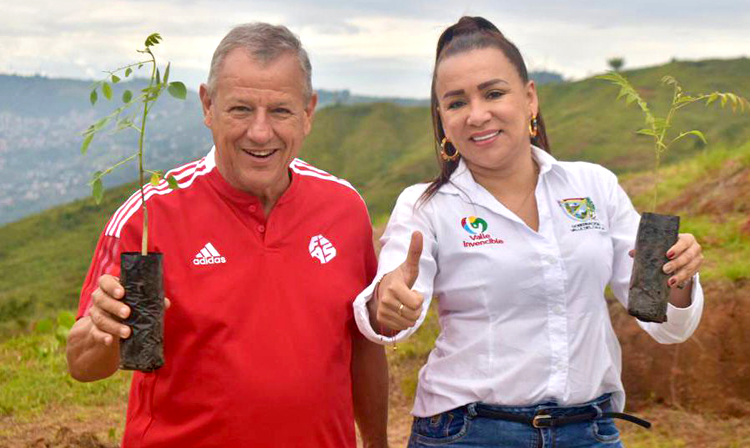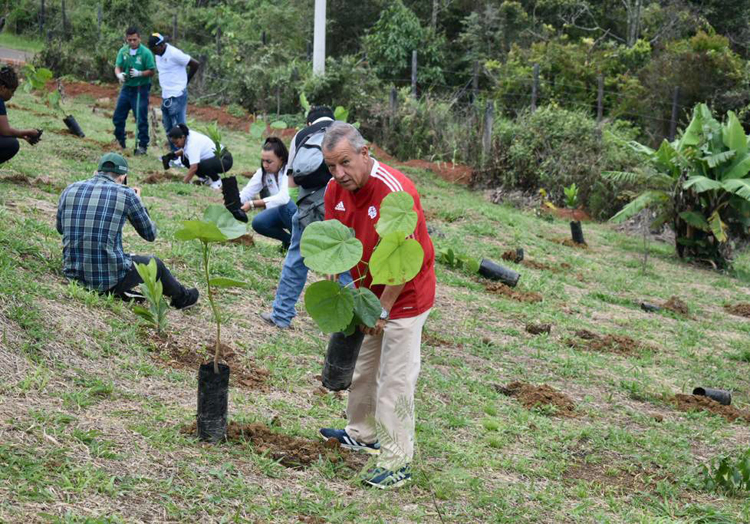Colombia's SAMBO Forest grows by 1,000 trees for International Day of Forests and World Water Day

In 2019, the SAMBO Forest appeared on the outskirts of the Colombian city of Cali. Its creators were the participants of the international SAMBO training camp - athletes from 8 countries of Pan-America with the support of the International SAMBO Federation. After a break of 3 years caused by the coronavirus pandemic, another 1,000 trees were planted in the SAMBO Forest. The action took place on March 22 as part of the World Water Day with the support of the government of the department of Valle del Cauca.

“This time the event was attended by a large number of volunteers from Colombia. These are young caring guys, from elementary school students to representatives of various organizations who wanted to contribute to the protection of the ecology of their country and the popularization of SAMBO. I think that even those of them who have not practiced SAMBO until now have received an additional source of motivation to discover this sport for themselves,” said Omar Lopera, FIAS Vice President, President of the Pan American SAMBO Union.

World Water Day, within which the action took place, is aimed at raising awareness of the 2.2 billion people who do not have access to safe water. The main objective of World Water Day is to support the achievement of the United Nations (UN) Sustainable Development Goal 6: water and sanitation for all by 2030.
Interestingly, on March 21, on the eve of the action, the world celebrated the International Day of Forests, proclaimed by the UN General Assembly. The goal set by the organization is to draw attention to the importance of all types of forests and the problem of their conservation. In turn, FIAS draws attention to the relevance of the tasks of the International Day of the Forest and the World Day of Water Resources.
Statistically, forests are home to about 80% of the world's terrestrial biodiversity, with more than 60,000 tree species.
"Forests and sustainable production and consumption" - is the theme of the International Day of Forests in 2022 is for the benefit of people and the planet. Today, wood is used in various fields, including space exploration. Therefore, the consumption and production of wood are vital to our planet.
The International SAMBO Federation urges attention to the importance of forest conservation, and that's why:
There are about 3 trillion trees on Earth, which is only half as many as 12,000 years ago, and people cut down an estimated 15 billion trees each year.
Carbon dioxide is the main gas that causes global warming. Through photosynthesis, trees and other plants transform carbon dioxide from the atmosphere into carbohydrates, which they use to make stems, leaves, and roots.
But it is important not only to conserve forests but also to plant. To offset the average person's 16.2 metric tons of CO2 emissions, they need to plant about 8-10 trees a year.
Forest also protects against dangerous weather gives natural air conducting and food. Even a short time in nature helps health – increases vigour and reduces depression, anxiety, and fatigue.
And last but not least – many jobs depend on the forest, such as logging, carpentry, and woodworking, foresters to rangers, conservationists, sustainable agroforestry farmers, tour guides, nature photographers, herbalists, foragers, tree planters, and more, over 1.6 billion people rely on forests for their livelihoods.
The availability of water directly affects the health of forests and their inhabitants, highlighting the importance of the relationship between forests and water. Trees are over 50 percent water and need a constant source to grow and stay healthy. Water from the soil enters their roots and is carried up the tree trunk to the leaves.
Trees serve as natural sponges, collecting and filtering rainfall and slowly releasing it into streams and rivers, and are the adequate vegetation cover for maintaining water quality.
- ВКонтакте
- РћРТвЂВВВВВВВВнокласснРСвЂВВВВВВВВРєРСвЂВВВВВВВВ
- РњРѕР№ Р В Р’В Р РЋРЎв„ўР В Р’В Р РЋРІР‚ВВВВВВВВРЎР‚
-
Did you see it? 29 MaySAMBO Without Borders: Friendly Encounter Between Tashkent and London Clubs Held in Uzbekistan
-
Did you see it? 11 April[VIDEO] The First SAMBO Athlete in Space - Oleg Artemyev. Documentary
-
Did you see it? 20 August[VIDEO] SAMBO competition among Indian schoolchildren held in Kerala
-
Competitions 25 JulySAMBO Athletes to Compete for a Unique Medal at The World Games 2025
-
Personalities 23 JulyRoman SHAKIROV: “Our goal is the first place at The World Games 2025”
-
Mass media 22 JulyThe World Games 2025 SAMBO Tournament to Stream Live
- Watch World Sambo Championships 2022. Bishkek, Kyrgyzstan 17 November 2022
-
Competitions 25 JulySAMBO Athletes to Compete for a Unique Medal at The World Games 2025
-
Personalities 23 JulyRoman SHAKIROV: “Our goal is the first place at The World Games 2025”
-
Mass media 22 JulyThe World Games 2025 SAMBO Tournament to Stream Live
